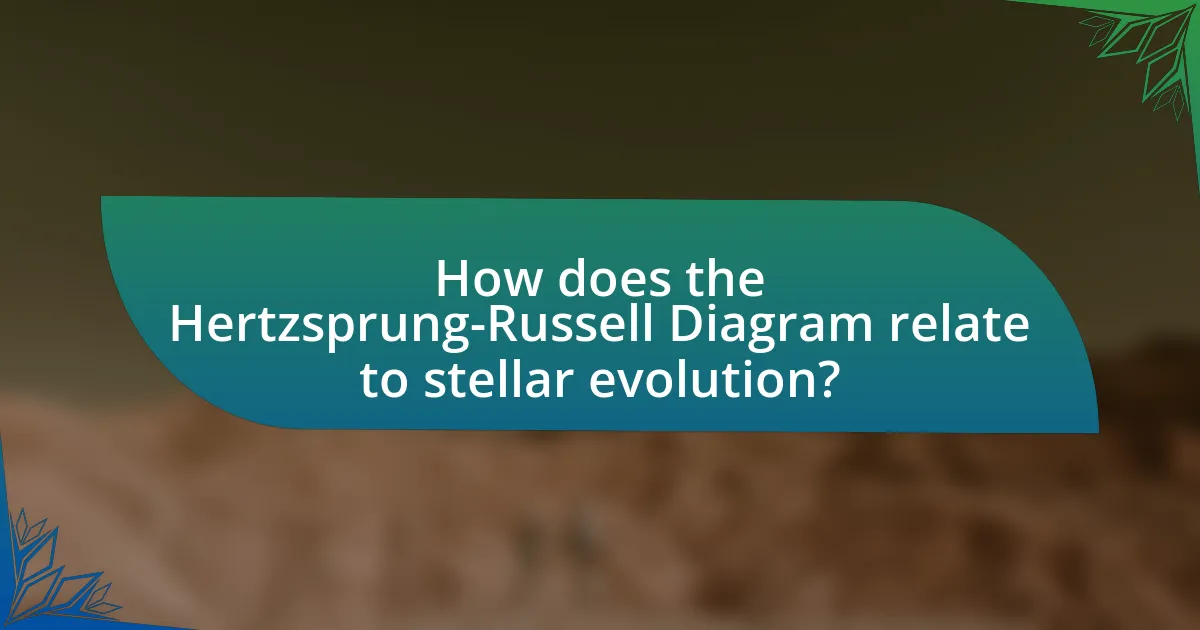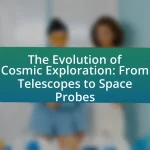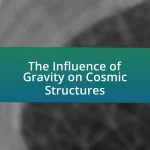The Hertzsprung-Russell Diagram is a crucial tool in astrophysics that categorizes stars based on their luminosity and temperature, revealing insights into their evolutionary stages. Developed by astronomers Ejnar Hertzsprung and Henry Norris Russell in the early 20th century, the diagram illustrates the relationship between a star’s brightness and temperature, allowing for the classification of stars into groups such as main sequence stars, giants, and white dwarfs. This article explores the development of the diagram, its key components, its significance in understanding stellar evolution, and the limitations that affect its accuracy, while also discussing complementary methods that enhance its application in astronomical research.

What is the Hertzsprung-Russell Diagram?
The Hertzsprung-Russell Diagram is a graphical representation that plots stars according to their luminosity and temperature. This diagram categorizes stars into distinct groups, such as main sequence stars, giants, and white dwarfs, based on their evolutionary stages. The relationship between a star’s temperature and its brightness reveals critical insights into stellar evolution, as established by astronomers Ejnar Hertzsprung and Henry Norris Russell in the early 20th century. Their work demonstrated that the majority of stars, including our Sun, reside along the main sequence, where they spend most of their lifetimes fusing hydrogen into helium.
How was the Hertzsprung-Russell Diagram developed?
The Hertzsprung-Russell Diagram was developed through the independent work of astronomers Ejnar Hertzsprung and Henry Norris Russell in the early 20th century. Hertzsprung initially plotted the absolute magnitudes of stars against their spectral types, revealing a correlation between brightness and temperature. Russell later expanded on this by incorporating the concept of stellar evolution, demonstrating that stars occupy distinct regions in the diagram based on their evolutionary stages. Their combined efforts established the diagram as a fundamental tool in understanding stellar properties and evolution, providing insights into the life cycles of stars.
Who were Hertzsprung and Russell, and what were their contributions?
Hertzsprung and Russell were astronomers known for their significant contributions to the understanding of stellar evolution through the Hertzsprung-Russell diagram. Ejnar Hertzsprung and Henry Norris Russell independently developed this diagram in the early 20th century, which plots stars according to their absolute magnitude and temperature. This graphical representation allowed for the classification of stars into distinct groups, revealing relationships between their luminosity, temperature, and evolutionary stages. Their work laid the foundation for modern astrophysics, enabling further studies on stellar life cycles and the properties of stars.
What historical context led to the creation of the diagram?
The Hertzsprung-Russell Diagram was created in the early 20th century as a result of advancements in stellar classification and the understanding of stellar evolution. This period saw astronomers like Ejnar Hertzsprung and Henry Norris Russell independently plotting the relationship between a star’s absolute magnitude and its spectral type, which revealed distinct patterns in stellar properties. The diagram emerged from the need to categorize stars based on their luminosity and temperature, leading to significant insights into the life cycles of stars, including the identification of main sequence stars, giants, and white dwarfs. The foundational work of these astronomers was built upon earlier studies of stellar spectra and photometry, which provided the necessary data for the diagram’s development.
What are the key components of the Hertzsprung-Russell Diagram?
The key components of the Hertzsprung-Russell Diagram are the axes representing stellar luminosity and temperature. The vertical axis typically shows luminosity, often measured in solar units, while the horizontal axis displays temperature, usually in Kelvin, decreasing from left to right. This diagram categorizes stars into distinct groups, such as main sequence stars, giants, and white dwarfs, based on their luminosity and temperature. The arrangement of stars in this diagram reflects their evolutionary stages, with main sequence stars occupying a diagonal band from the upper left (hot, luminous stars) to the lower right (cool, dim stars). This classification is supported by observational data from various star catalogs, confirming the relationship between a star’s temperature and its luminosity.
What axes are represented in the diagram?
The axes represented in the Hertzsprung-Russell diagram are luminosity and temperature. The vertical axis typically shows the star’s luminosity, often measured in solar units, while the horizontal axis displays the star’s surface temperature, usually in Kelvin. This structure allows for the classification of stars based on their brightness and temperature, illustrating their evolutionary stages in stellar evolution.
How are stars categorized within the diagram?
Stars are categorized within the Hertzsprung-Russell diagram based on their luminosity and temperature. The diagram plots stars on a graph where the vertical axis represents luminosity (or absolute magnitude) and the horizontal axis represents temperature (or spectral class), typically decreasing from left to right. This categorization reveals distinct groups, such as main sequence stars, giants, supergiants, and white dwarfs, each occupying specific regions of the diagram. For instance, main sequence stars, which include the majority of stars like our Sun, are found along a diagonal band from the upper left (hot, luminous stars) to the lower right (cool, dim stars). This classification is validated by the correlation between a star’s temperature and its brightness, as established through observational data and stellar models.
Why is the Hertzsprung-Russell Diagram important in stellar evolution?
The Hertzsprung-Russell Diagram is crucial in stellar evolution because it visually represents the relationship between a star’s luminosity, temperature, and evolutionary stage. This diagram categorizes stars into distinct groups, such as main sequence, giants, and white dwarfs, allowing astronomers to understand their life cycles and predict their future development. For instance, the position of a star on the diagram indicates its mass and age, which are fundamental in studying stellar formation and evolution processes. The diagram has been validated through extensive observational data, demonstrating consistent patterns that correlate with theoretical models of stellar evolution.
What insights does the diagram provide about star life cycles?
The diagram provides insights into the various stages of star life cycles, illustrating the relationship between a star’s luminosity and its temperature. It categorizes stars into distinct groups, such as main sequence stars, giants, and white dwarfs, based on their evolutionary phases. The Hertzsprung-Russell Diagram shows that stars spend the majority of their lives in the main sequence phase, where they fuse hydrogen into helium. As stars exhaust their hydrogen fuel, they evolve into red giants or supergiants, depending on their mass. This transition is marked by significant changes in luminosity and temperature, which the diagram effectively visualizes. The diagram also indicates that more massive stars have shorter life spans, leading to supernova events, while less massive stars can evolve into white dwarfs, demonstrating the diversity of stellar evolution.
How does the diagram help in understanding stellar populations?
The Hertzsprung-Russell diagram helps in understanding stellar populations by visually representing the relationship between a star’s luminosity, temperature, and evolutionary stage. This diagram categorizes stars into distinct groups, such as main sequence stars, giants, and white dwarfs, allowing astronomers to identify the characteristics and life cycles of different stellar populations. For instance, the position of a star on the diagram indicates its age and composition, with main sequence stars being in a stable phase of hydrogen burning, while giants and supergiants represent later evolutionary stages. This classification is supported by observational data, such as the distribution of stars in clusters, which reveals patterns consistent with stellar evolution theories.

How does the Hertzsprung-Russell Diagram relate to stellar evolution?
The Hertzsprung-Russell Diagram (HR Diagram) illustrates the relationship between a star’s luminosity, temperature, and evolutionary stage, making it essential for understanding stellar evolution. The diagram categorizes stars into distinct groups, such as main sequence stars, giants, and white dwarfs, based on their properties. This categorization allows astronomers to track the life cycle of stars, from their formation in nebulae to their eventual death as supernovae or white dwarfs. The HR Diagram also reflects the changes in a star’s temperature and brightness over time, providing insights into the processes of nuclear fusion and energy production within stars. For instance, as a star exhausts its hydrogen fuel, it moves off the main sequence and evolves into a red giant, demonstrating the dynamic nature of stellar evolution.
What stages of stellar evolution can be identified using the diagram?
The stages of stellar evolution identified using the Hertzsprung-Russell diagram include the main sequence, red giant phase, horizontal branch, asymptotic giant branch, and white dwarf stage. The diagram plots stars based on their luminosity and temperature, allowing for the classification of these evolutionary stages. For instance, stars on the main sequence are fusing hydrogen into helium, while those in the red giant phase have exhausted hydrogen in their cores and are undergoing helium fusion. This classification is supported by observational data from various star clusters, which show distinct groupings corresponding to these evolutionary stages.
How do main sequence stars evolve over time?
Main sequence stars evolve over time primarily through the process of nuclear fusion, where hydrogen in their cores is converted into helium. As a main sequence star ages, the hydrogen fuel in its core depletes, leading to changes in its internal structure and energy production. This depletion causes the core to contract and heat up, which eventually allows the star to start fusing helium into heavier elements.
As a result of these changes, the star will move off the main sequence on the Hertzsprung-Russell Diagram, transitioning into the red giant phase. For example, our Sun, currently a main sequence star, is expected to exhaust its hydrogen in about 10 billion years, after which it will expand into a red giant and ultimately shed its outer layers, leaving behind a white dwarf. This evolutionary path is supported by stellar models and observations of various star clusters, which show distinct stages of stellar evolution consistent with the predictions of the Hertzsprung-Russell Diagram.
What are the characteristics of red giants and supergiants in the diagram?
Red giants and supergiants are characterized by their large size, low surface temperature, and high luminosity in the Hertzsprung-Russell Diagram. Red giants typically have a surface temperature ranging from 2,200 to 4,000 Kelvin and occupy the upper right region of the diagram, indicating their significant expansion and cooling compared to main-sequence stars. Supergiants, on the other hand, are even larger and more luminous, with temperatures that can vary widely but often exceed 5,000 Kelvin, placing them in the upper part of the diagram. Their luminosity can be thousands of times greater than that of the Sun, reflecting their massive size and energy output. These characteristics are essential for understanding stellar evolution, as they indicate the later stages of a star’s life cycle, where hydrogen in the core is depleted and helium fusion begins.
How does the Hertzsprung-Russell Diagram assist in predicting stellar behavior?
The Hertzsprung-Russell Diagram assists in predicting stellar behavior by categorizing stars based on their luminosity, temperature, and evolutionary stage. This classification allows astronomers to infer a star’s life cycle, including its age, size, and eventual fate, by placing it within the diagram’s distinct regions, such as the main sequence, red giants, and white dwarfs. For example, stars on the main sequence fuse hydrogen into helium, while those in the red giant phase have exhausted hydrogen in their cores and are undergoing different fusion processes. This systematic arrangement is supported by observational data, such as the correlation between temperature and luminosity, which has been validated through extensive studies of stellar populations.
What role does the diagram play in understanding stellar temperatures and luminosities?
The Hertzsprung-Russell diagram plays a crucial role in understanding stellar temperatures and luminosities by visually representing the relationship between these two fundamental properties of stars. This diagram categorizes stars based on their absolute magnitudes (luminosities) and effective temperatures, allowing astronomers to identify patterns and evolutionary stages of stars. For instance, main-sequence stars, which occupy a diagonal band on the diagram, exhibit a direct correlation where higher temperatures correspond to greater luminosities, illustrating the physical processes occurring in stellar cores. This correlation is supported by the Stefan-Boltzmann Law, which states that a star’s luminosity is proportional to the fourth power of its temperature, reinforcing the diagram’s utility in stellar classification and evolution studies.
How can the diagram be used to estimate the age of star clusters?
The Hertzsprung-Russell diagram can be used to estimate the age of star clusters by analyzing the position of stars within the diagram, particularly focusing on the main sequence turn-off point. The turn-off point indicates the stage at which stars begin to leave the main sequence and evolve into red giants, which correlates with the cluster’s age; older clusters have a turn-off point at a lower mass compared to younger clusters. This relationship is supported by stellar evolution models, which show that more massive stars evolve faster and leave the main sequence sooner, allowing astronomers to determine the cluster’s age based on the observed turn-off mass.

What are the limitations of the Hertzsprung-Russell Diagram?
The Hertzsprung-Russell Diagram has several limitations, primarily its inability to represent all types of stars and their evolutionary stages accurately. For instance, it does not effectively depict the characteristics of binary star systems, which can complicate the interpretation of their luminosity and temperature. Additionally, the diagram primarily focuses on main-sequence stars, neglecting other important phases such as red giants and white dwarfs, which can lead to an incomplete understanding of stellar evolution. Furthermore, the diagram relies on the assumption of a standard distance to stars, which can introduce errors in luminosity calculations if the distance is not accurately known. These limitations highlight the need for complementary methods and tools in the study of stellar evolution.
What factors can affect the accuracy of the diagram?
The accuracy of the Hertzsprung-Russell diagram can be affected by factors such as measurement errors in stellar brightness and temperature, the distance to stars, and the effects of interstellar dust. Measurement errors can arise from limitations in observational technology, leading to incorrect luminosity or temperature readings. The distance to stars can introduce parallax errors, which affect the perceived brightness. Additionally, interstellar dust can obscure light from stars, altering their apparent brightness and skewing the diagram’s representation. These factors collectively impact the reliability of the diagram in depicting stellar evolution.
How do interstellar dust and gas influence observations?
Interstellar dust and gas significantly influence astronomical observations by obscuring and reddening the light from distant stars and galaxies. This phenomenon occurs because dust particles scatter and absorb light, leading to a reduction in visibility and altering the perceived color of celestial objects. For instance, the presence of interstellar dust can cause a star’s light to appear redder than it actually is, a process known as interstellar reddening. This effect complicates the accurate determination of a star’s temperature and luminosity, which are essential for plotting stars on the Hertzsprung-Russell Diagram. Studies have shown that up to 50% of the light from certain regions of the Milky Way can be absorbed by interstellar dust, significantly impacting the interpretation of stellar evolution and the overall understanding of the universe.
What are the challenges in classifying stars accurately?
Classifying stars accurately presents several challenges, primarily due to the vast diversity in their properties and the limitations of observational techniques. The variability in stellar brightness, temperature, and composition complicates classification, as stars can exhibit different characteristics at various stages of their life cycles. For instance, a star’s position on the Hertzsprung-Russell Diagram can change as it evolves, making it difficult to categorize it consistently. Additionally, the presence of interstellar dust can obscure observations, leading to inaccurate measurements of a star’s luminosity and distance. These factors collectively hinder precise classification, as evidenced by the ongoing revisions in stellar classification systems to accommodate new discoveries and data.
How can the limitations of the Hertzsprung-Russell Diagram be addressed?
The limitations of the Hertzsprung-Russell Diagram can be addressed by incorporating additional data from other observational methods and theoretical models. For instance, integrating information from spectroscopy can provide insights into stellar compositions and temperatures, which enhances the accuracy of stellar classifications beyond the diagram’s basic luminosity and temperature parameters. Furthermore, utilizing asteroseismology allows for a better understanding of stellar interiors, leading to more precise age and evolutionary stage determinations. These methods collectively improve the diagram’s utility in representing diverse stellar populations and evolutionary paths, thereby overcoming its inherent limitations.
What advancements in technology improve our understanding of stellar evolution?
Advancements in technology that improve our understanding of stellar evolution include high-resolution spectroscopy, space-based telescopes, and computational modeling. High-resolution spectroscopy allows astronomers to analyze the chemical composition and physical properties of stars, providing insights into their life cycles. Space-based telescopes, such as the Hubble Space Telescope and the upcoming James Webb Space Telescope, enable observations free from atmospheric interference, allowing for more accurate measurements of stellar brightness and distance. Computational modeling has advanced significantly, enabling simulations of stellar processes that predict the behavior of stars at various stages of their evolution. These technologies collectively enhance our ability to interpret the Hertzsprung-Russell Diagram, which illustrates the relationship between a star’s luminosity and temperature, thereby deepening our understanding of stellar evolution.
How do complementary methods enhance the insights gained from the diagram?
Complementary methods enhance insights gained from the Hertzsprung-Russell diagram by providing additional data and context that clarify stellar properties and evolutionary stages. For instance, spectroscopic analysis allows astronomers to determine a star’s composition and temperature, which can be cross-referenced with the diagram to better understand its position and lifecycle. Furthermore, photometric measurements contribute to accurate distance calculations, enabling a more precise placement of stars on the diagram. This integration of methods leads to a comprehensive understanding of stellar evolution, as evidenced by studies that correlate spectral classifications with evolutionary tracks on the diagram, revealing patterns in star formation and lifecycle transitions.
What practical applications arise from understanding the Hertzsprung-Russell Diagram?
Understanding the Hertzsprung-Russell Diagram enables astronomers to classify stars based on their luminosity, temperature, and evolutionary stage, which has practical applications in stellar evolution research. This classification aids in predicting the life cycle of stars, including their formation, main sequence, and eventual death, allowing scientists to estimate the age of star clusters and the chemical evolution of galaxies. For instance, by analyzing the positions of stars on the diagram, researchers can infer the distance to stars and their masses, which are critical for understanding the dynamics of stellar populations. Additionally, the diagram assists in identifying exoplanetary systems by providing context for the host stars’ characteristics, thereby enhancing the search for habitable worlds.
How can astronomers use the diagram in their research?
Astronomers can use the Hertzsprung-Russell diagram to classify stars based on their luminosity and temperature, which aids in understanding stellar evolution. By plotting stars on this diagram, astronomers can identify their stages of life, such as main sequence, red giant, or white dwarf, allowing for predictions about their future development. This classification is supported by the correlation between a star’s position on the diagram and its physical properties, as established by studies like those conducted by Hertzsprung and Russell in the early 20th century, which demonstrated the relationship between a star’s brightness and its temperature.
What educational resources are available for learning about the diagram?
Educational resources for learning about the Hertzsprung-Russell Diagram include online courses, textbooks, and academic articles. Online platforms like Coursera and edX offer courses on stellar evolution that cover the diagram in detail. Textbooks such as “An Introduction to Modern Astrophysics” by Andrew J. Smith provide comprehensive explanations and illustrations of the diagram. Additionally, peer-reviewed articles in journals like “The Astrophysical Journal” often discuss the diagram’s applications in stellar classification and evolution, providing concrete examples and data to enhance understanding.




